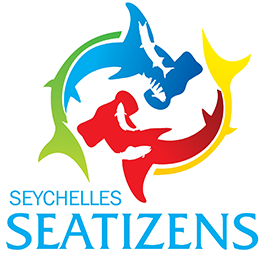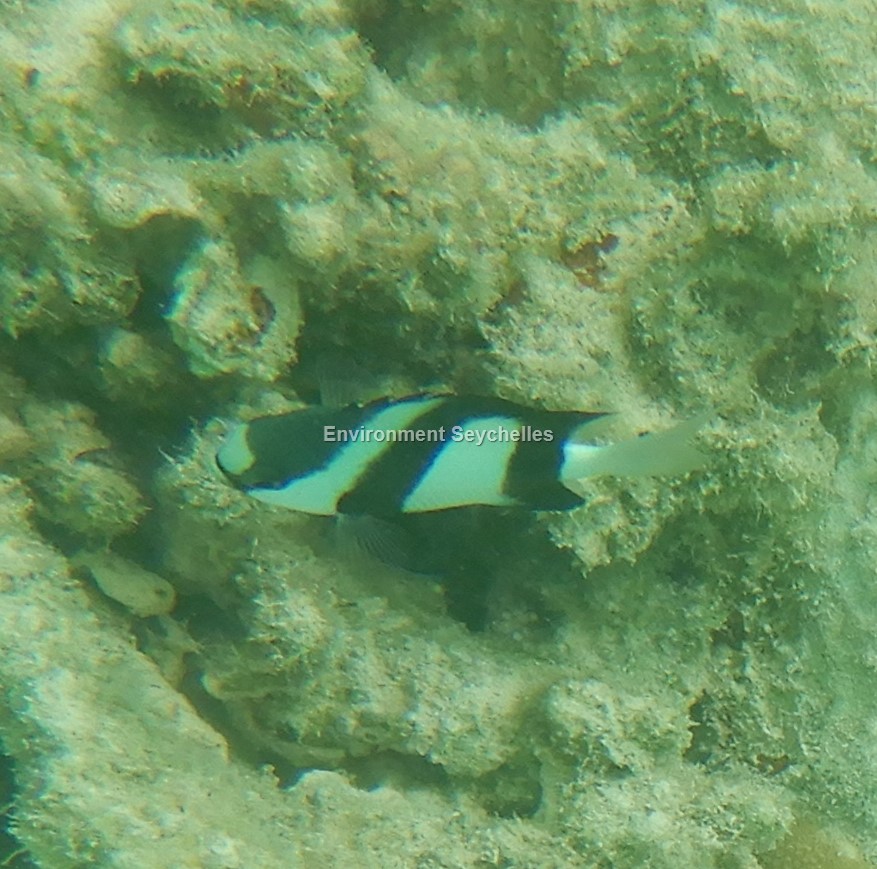Description:
Dorsal spines: 12; Dorsal rays: 11-13; Anal spines: 2; Anal rays: 11-13.
A small dascyllus. Margins of preorbital, suborbital, and preoperculum finely serrated. Caudal fin bilobate.
Colour: White base colour with three transversal black bands. The anterior band leaving a large white spot between the eyes. Lips dusky or white.
Pectoral fins transparent. Middle band incorporates black pelvic fins.Typically possesses a grey to blackish blotch at the base of the caudal fin that
distinguishes it from its Pacific-Ocean sister-species, Dascyllus aruanus, whose tail is generally entirely white.
Differs from D. aruanus by its cytochrome b gene sequence: nucleotide sites nos. 450, 459 and 702 of the gene (diagnostic between the two species) and
at these three sites, D. abudafur has the triplet (A, T, T) whereas D. aruanus has (G, C, C).
Size:
Maturity: Unknown. Max length : 10.0 cm TL. Common length : 6.0 cm TL.
Habitat and Ecology:
Occurs in the Indian Ocean: Red Sea to the Sunda Shelf. Inhabits shallow lagoon and subtidal reef flats (0-20 m depth).It has a close association with
branching corals. It is found in small to large aggregations. Feeds on zooplankton in the water column, benthic invertebrates, and algae. Diurnal.
Oviparous, distinct pairing during breeding.
Fishery Status:
This species is not protected or subject to fishery regulations. It is not subject to the artisanal fishery.
Notes:
Photos taken at Port Launay (20/03/23) at 3-4 m depth.
Formerly considered as Dascyllus aruanus, genetic and phenotypic differences were identified (Borsa et al. 2014) that led to the western Indian Ocean
populations being distinguished as a distinct species. "Possesses a grey to blackish blotch at the basis of caudal fin that distinguishes it from its
Pacific-Ocean sister-species, Dascyllus aruanus, whose tail is generally entirely white. Also distinct from D. aruanus by its cytochrome b
gene sequence: nucleotide sites nos. 450, 459 and 702 of the gene are diagnostic between the two species (Fig.3). At these three sites, D. abudafur has
the triplet (A, T, T) whereas D. aruanus has (G, C, C)." (Borsa et al 2014).
Interestingly the specimen photo'd here exhibits a white tail which is more typical of the Pacific species - this is interpreted as variation within
D. abudafur, itself the consequence of incomplete morphological differentiation between the Indian Ocean and the Pacific Ocean species. The Borsa et al.
study which did find some white-tailed specimens but still found the genetic distinction.
References:
Allen, G.R. et al. (2022). Dascyllus aruanus. The IUCN Red List 2022: https://dx.doi.org/10.2305/IUCN.UK.2022-2.RLTS.T188433A1874014.en. (21/03/23).
Borsa, P. et al. (2014). Resurrection of Indian Ocean humbug damselfish, Dascyllus abudafur (Forsskål) from synonymy with its Pacific Ocean sibling, Dascyllus
aruanus (L.). Comptes Rendus Biologies, 2014, 337, pp.709-716. 10.1016/j.crvi.2014.09.001.ird-01144018
Bray, D.J. (2020). Dascyllus aruanus in Fishes of Australia, https://fishesofaustralia.net.au/home/species/347 (21/03/23).
Froese, R. & D. Pauly. (Eds.) (2023). FishBase. Dascyllus abudafur (Forsskål, 1775). https://www.fishbase.se/summary/68973 (21/03/23).
Froese, R. & D. Pauly. (Eds.) (2023). FishBase. Dascyllus aruanus (Linnaeus, 1758). https://www.fishbase.se/summary/Dascyllus-aruanus.html (21/03/23).
Citation:
Nevill, J.E.G. (2023). Dascyllus abudafur, Indian Ocean humbug damslefish. Seychelles Seatizens. www.seatizens.sc. https://seatizens.sc/species/dascyllus-abudafur-forsskal-1775/



I think this is a real great article.Much thanks again. Awesome.
Thanks a lot for the blog article.Thanks Again. Cool.
I truly appreciate this post.Really looking forward to read more. Really Cool.
Muchos Gracias for your article post.Really thank you! Keep writing.
Thank you ever so for you article post. Really Great.
I really liked your blog article.Really looking forward to read more. Will read on…
Very neat article post.Really thank you! Awesome.
Thank you ever so for you article.Really thank you! Really Great.
I loved your blog article.Really looking forward to read more. Want more.
wow, awesome blog post.Thanks Again. Want more.
This is one awesome blog. Really Cool.
I loved your blog article. Really Cool.
Thanks for the blog post.Really looking forward to read more. Will read on…
I value the article.Really looking forward to read more. Will read on…
I really enjoy the blog.Really thank you! Much obliged.
Im obliged for the post.Really thank you! Great.
Really enjoyed this article post.Thanks Again. Really Great.
Awesome blog post. Really Cool.
Im grateful for the article post.Really thank you! Keep writing.
Thanks again for the blog.Thanks Again. Fantastic.
Looking forward to reading more. Great blog article.Really thank you! Great.
Thanks so much for the blog.Really looking forward to read more. Want more.
Thanks-a-mundo for the article post.Much thanks again. Really Great.
Thanks so much for the post.Really thank you! Cool.
Wow, great blog post.Really looking forward to read more. Keep writing.
Very good blog post.Much thanks again. Cool.
Im thankful for the blog post.Really thank you! Will read on…
I really enjoy the blog post.Much thanks again. Great.